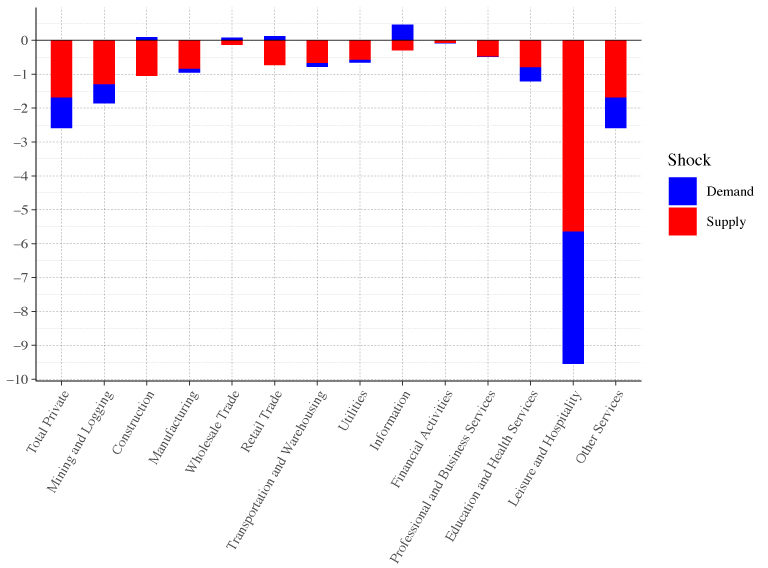Research Home > COVID-19 Resources > Preliminary Print
PRELIMINARY: Is the COVID-19 Pandemic a Supply or a Demand Shock?
by Pedro Brinca, Joao B. Duarte, and Miguel Faria-e-Castro
Posted online May 19, 2020
In response to the COVID-19 outbreak, public health authorities around the world implemented mitigation measures such as social distancing, which shut down entire sectors of the economy, especially those that involve interpersonal contact, such as restaurants, hairdressers, airlines, etc. While authorities have forced many such establishments to close and send their workers home (so-called lockdowns), consumers themselves also decreased their use of these services.1 Further, newly jobless workers reduced their consumption of all goods and services.
That is, uncertainty about the evolution of the pandemic reduced both the supply of certain types of goods and services and the demand for them. For this reason, most economists would agree that the pandemic combines aspects of both “supply” and “demand” shocks. A supply shock is anything that reduces the economy’s capacity to produce goods and services, at given prices. Lockdown measures preventing workers from doing their jobs can be seen as a supply shock. A demand shock, on the other hand, reduces consumers’ ability or willingness to purchase goods and services, at given prices. People avoiding restaurants for fear of contagion is an example of a demand shock. Additionally, as service sector workers lose their jobs and income, they stop purchasing all kinds of goods, such as cars and appliances, which can also be thought of as a sectoral demand shock.
Conventional monetary and fiscal policy can offset some types of aggregate demand shocks, but other policies may be more appropriate to counter supply shocks. Understanding whether supply or demand causes a particular shock is therefore very important for policy design. The government doesn’t want to stimulate activity in certain service sectors because of concerns about further spreading the pandemic. The government could, however, stimulate sectors that are not part of the lockdown but are subject to aggregate shocks. This means that it is important to understand whether supply and demand shocks affect each sector.
In a recent paper (Brinca, Duarte, and Faria-e-Castro, 2020), we use data on hours worked and real wages for the U.S. to estimate labor demand and supply shocks for the aggregate economy and for different sectors. The following simple assumptions identify supply and demand shocks: if hours and wages (prices and quantities) move in the same direction, we assign more probability to those movements being caused by a demand shock. On the other hand, if hours and wages move in opposite directions, we assign a higher probability to a supply shock.2
Figure 1: Shock Decomposition for March 2020

Figure 1 plots the shock decomposition for March 2020, when the lockdown began, for the growth rate of hours worked. The sum of the red and blue bars is the percentage point change in the growth rate of hours worked relative to its historical average; the size of the red bar relative to the blue bar shows how important supply shocks were relative to demand shocks in that sector. For example, the first “sector” is total private employment, which fell about 2.5 percent (non-annualized); supply shocks accounted for about two-thirds of that decline in hours. By far the most-affected sector was Leisure and Hospitality, where the growth rate of hours worked fell by almost 10 percentage points. Again, supply played a slightly larger role than demand. While most sectors experienced negative supply shocks, some sectors experienced small positive demand shocks; for example, retail trade likely benefited as people stopped going to restaurants and started buying more groceries and cooking at home. The Information sector also benefited, likely due to increased interest in telecommuting.
Figure 2: Shock Decomposition for April 2020

Figure 2 repeats the exercise for April 2020, the first full month of lockdown. Total private employment fell by almost 17 percentage points in April, about 10 times as much as in March. Again, supply shocks seemed to explain about two-thirds of the decrease for most sectors. Also, during this month, the positive demand shocks in sectors such as Retail and Information vanished—or even reversed.
All in all, our results suggest that labor supply shocks accounted for most of the fall in hours in March and April, but demand shocks were also important. In particular, there were significant demand shocks in sectors that should not be very directly affected by the lockdown, such as Manufacturing. This suggests that targeted stabilization policy could help assuage the effects of the current crisis.
Footnotes
1 For example, a recent paper (Andersen, Hansen, Johannesen, and Sheridan, 2020) compares personal expenditures between Denmark, a country that imposed a lockdown, and Sweden, a country that did not, and finds that consumption expenditures fell in both countries by similar amounts.
2 This builds on work by Baumeister and Hamilton (2015).
References
Andersen, A.L., Hansen, E.T., Johannesen, N., and Sherdian, A. (2020) “Pandemic, Shutdown and Consumer Spending: Lessons from Scandinavian Policy Responses to COVID-19.” COVID-19 e-print available at arXiv:2005.04630.
Baumeister, C., and Hamilton, J. (2015) “Sign Restrictions, Structural Vector Autoregressions, and Useful Prior Information.” Econometrica 83(5), 1963–1999.
Brinca, P., Duarte, J.B., and Faria-e-Castro, M. (2020) “Measuring Sectoral Supply and Demand Shocks during COVID-19.” Federal Reserve Bank of St. Louis Working Paper 2020-011B.
Preliminary, incomplete. To cite, please request author’s permission.
© 2020, Federal Reserve Bank of St. Louis. These views do not reflect the opinion of the Federal Reserve Bank of St. Louis or the Federal Reserve System.
Browse more resources on COVID-19 from the Research Division